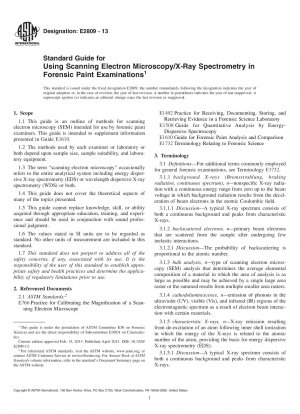ASTM E2809-13
Standard Guide for Using Scanning Electron Microscopy/X-Ray Spectrometry in Forensic Paint Examinations
- Standard No.
- ASTM E2809-13
- Release Date
- 2013
- Published By
- American Society for Testing and Materials (ASTM)
- Status
- Replace By
- ASTM E2809-22
- Latest
- ASTM E2809-22
- Scope
4.1 The SEM can be used to define and compare the layer structure of multilayered samples, the structure of individual layers, the bulk elemental composition of individual layers, and the elemental composition of individual particulate components within paints and coatings.
4.2 The test methods described in this guide may have some limitations. They include the inability to detect elements in trace concentrations, the need for a conductive coating of the sample, the inability to remove a sample from most embedding materials after analysis, and the discoloration of materials by irradiation.
4.3 Although quantitative and semiquantitative methods are available for EDS (see Guide E1508), they are not appropriate for most paint analyses because of the typical heterogeneity of paint. Application of quantitative methods is further complicated by an inability to predict what compounds may be present (see 7.12.1).
4.4 The information available from a specimen may diminish as its size is reduced and its condition degrades. The smaller a specimen is, the less valuable it becomes for association with a known because it may contain fewer characteristics of the original material. As specimen size is reduced, it may no longer be representative of the original material. This may also be true of a degraded sample.
4.5 This guide is intended to advise and assist laboratory analysts in the effective application of scanning electron microscopy to the analysis of paint evidence. It is intended to be applicable to most modern scanning electron microscopes typically used in the forensic laboratory.
4.6 It is not the intention of this guide to present comprehensive methods of SEM. It is necessary that the analyst have an understanding of SEM operation and general concepts of specimen preparation before using this guide. This information is available from manufacturers’ reference materials, training courses, and references such as Scanning Electron Microscopy and X-ray Microanalysis: A Text for Biologists, Materials Scientists, and Geologists (1).3
1.1 This guide is an outline of methods for scanning electron microscopy (SEM) intended for use by forensic paint examiners. This guide is intended to supplement information presented in Guide E1610.
1.2 The methods used by each examiner or laboratory or both depend upon sample size, sample suitability, and laboratory equipment.
1.3 The term “scanning electron microscopy” occasionally refers to the entire analytical system including energy dispersive X-ray spectrometry (EDS) or wavelength dispersive X-ray spectrometry (WDS) or both.
1.4 This guide does not cover the theoretical aspects of many of the t......
ASTM E2809-13 Referenced Document
- ASTM E1492 Standard Practice for Receiving, Documenting, Storing, and Retrieving Evidence in a Forensic Science Laboratory
- ASTM E1508 Standard Guide for Quantitative Analysis by Energy-Dispersive Spectroscopy
- ASTM E1610 Standard Guide for Forensic Paint Analysis and Comparison
- ASTM E1732 Standard Terminology Relating to Forensic Science
- ASTM E766 Standard Practice for Calibrating the Magnification of a Scanning Electron Microscope
ASTM E2809-13 history
- 2022 ASTM E2809-22 Standard Guide for Using Scanning Electron Microscopy/Energy Dispersive X-Ray Spectroscopy (SEM/EDS) in Forensic Polymer Examinations
- 2013 ASTM E2809-13 Standard Guide for Using Scanning Electron Microscopy/X-Ray Spectrometry in Forensic Paint Examinations

Copyright ©2024 All Rights Reserved